Utah County Birders Newsletter
|
||||||||||||||||||||||||||||||||||||||||||||||||||||||||||||||||||||||
|
Dates
|
location
|
departure place and time
|
| Mar. 30 & 31 (new date!) |
Sharp-tailed grouse lek and Pocatello Valley, NW Utah | Friday: overnight stay in Brigham City
Crystal Inn (http://www.crystalinns.com/bgcut.html), UCB group rate $69,
call to reserve your room at 435-723-0440 and remember to mention you're
with the UCB group. Saturday: leave Crystal Inn Saturday morning 4:00 a.m.; leave Tremonton I-15 exit #385 4:30 a.m. |
| Apr. 14 | Fish Springs and Callao, west desert birds | day trip; Leave Payson Walmart 6:00 a.m. (I-15 exit #249?) |
| Apr. 27 & 28 | Torrey and Capitol Reef National Park | Friday: overnight in Torrey; Best Western
Capitol Reef Resort Torrey - UCB group rate $65, call Beth or Chris to
reserve your room at 435.425.3761 and remember to mention you're with the
UCB group. More details TBA |
| May 12 | Utah county desert birds - the great Utah County | day trip; leave Payson WalMart 7:00 a.m. More details TBA |
| May | Utah county Big Day with Dennis Shirley | trip is still being arranged and is not set; details TBA |
| May 17-22 | Great Salt Lake Bird Festival | please make your own arrangements |
| June 9 (to be confirmed) | Oquirrh Mountains with Ann Neville | day trip; details TBA |
| June 22 & 23 | Grouse Creek mountains, NW Utah | overnight in Brigham City Friday night; details TBA |
| July 13 & 14 | Bryce National Park | details TBA |
| Aug. 11 | Uintah Mountains North Slope road | day trip; details TBA |
| August | UOS conference; date and location pending | |
| September | Kennecott's Island Sea preserve with Ann Neville | day trip; date and details TBA |
| September | Brown's Park National Wildlife Refuge, NE Utah | overnight stay in Vernal |
| Oct. 13 & 14 | Zion's National Park | details TBA |
| Nov. 3 & 4 | Moab and Canyonlands National Park | details TBA |
| December | local Christmas bird counts, Provo CBC | details TBA |
| Dec. 29 | Bluff Christmas bird count | details TBA |
Merrill's Musings
By Merrill Webb
Mentors
In the teaching profession it is common to assign a more experienced teacher to
help and to monitor the progress of a new teacher--to be a mentor. This helps
the rookie teacher to monitor and to adjust to the challenges and the
frustrations that are so common to a first year teacher. This has proven to be
beneficial to the new educator because they don't become so easily discouraged,
plus it helps provide them with insights that might take longer to learn
otherwise. The whole idea is to help them become more proficient, to combat
discouragement, and to become more confident in their teaching.
I think back on my days of becoming successful at identifying birds. Each step
along the way there were mentors--someone who cared enough about me to help me
improve my skills and to keep me from becoming discouraged. I would like to
share with you the names of a few of those people who have mentored me.
The first one was my father. As a farmer he was out in the fields a lot and knew
many birds by sight. Some of the names of these birds were not in the field
guide, but nonetheless he knew what they were and he could identify most of
them. "Catbirds" "Peachbirds", "Greenheads", "Butcherbirds", and "Bullethawks"
were some of the birds I learned from him. And when I obtained my first
Peterson's Field Guide, I had to unlearn some of these names--and it took me a
while to do it. His "Catbirds" turned out to be Western Kingbirds; I couldn't
find "Peachbirds" anywhere in the index, (or the book), but I found out that
House Finches looked amazingly like what my dad referred to as "Peachbirds."
Even though some of the names were a bit off, he was still the first who
influenced my interest in birds.
After returning from six months active duty training in the military I enrolled
at Dixie Junior College in St. George, and promptly signed up for an ornithology
class without taking the prerequisite biology class. I assured the instructor,
Dr. Andrew
Barnum, that I could handle the class okay. I did alright, except for the
application of taxonomic principles. The lab was totally enjoyable because we
got to identify stuffed specimens during the two hours of each lab. And I became
pretty proficient. The only drawback was the requirement to learn the taxonomic
family and order of each bird, an exercise I considered in my youthful
inexperience to be superfluous and a waste of time. Dr. Barnum frequently asked
my advice on where to go for fieldtrips to look for certain species of birds
because I was out looking for birds a lot. I appreciated his confidence in my
abilities. But due to learning only the common names without the associated
classification levels I didn't do so well on the lab test and ended up receiving
a B for a final grade in the class, a mark that has always bothered me--because
with a little extra effort I could have done better. Since I have started
teaching my own zoology classes I have realized the error of my ways; I now know
how important classification is to the whole process of science--not just to
birds.
After graduating from Dixie I enrolled at BYU and my scientific training
intensified. However, I didn't really know where to look for birds in the Utah
County area. In the meantime I had joined the Salt Lake Audubon Society and went
on occasional fieldtrips with them. A lady by the name of Helen Chindgren took a
special interest in me and helped and encouraged me in learning some of the
birds in this area. I remember joining them for a fieldtrip to Farmington Bay
Waterfowl Management Area, a location I had always wanted to visit. With her
encouragement I started on my journey of becoming a more competent observer of
waterfowl. And I even had the opportunity the following summer of working at
Farmington Bay as a trainee for the Utah Division of Wildlife Resources where I
really improved in my waterfowl identification skills.
Later, in 1971, a local chapter of the Audubon Society was organized here in
Utah Valley, and another special person took an interest in helping me. I had
taken a religion class from him at BYU, and he had never mentioned his interest
in birds in class during that semester. But due to the association that occurred
through that chapter Bob Parsons and I soon started taking a lot of birding
trips together. He was instrumental in helping me improve my identification
skills. On one trip he took me and Daniel Simmons, a high school student, on an
overnight trip into the Uintahs to see some of the
birds associated with the alpine environment. We made camp in the dark. The next
morning we heard a lot of activity in the tree above us. Looking up we
discovered we had pitched our tent right under an active nest of a Williamson's
Sapsucker, a "lifer" for me.
Gradually, my skills improved, but there was one group of birds that still gave
me fits. These were the shorebirds, especially during fall migration. In fact, I
usually totally avoided mudflats during September and October so I wouldn't be
so frustrated at trying to identify them. However, there was a graduate student
attending Utah State University who was very good at shorebird identification.
Mike Tove was from North Carolina where he had developed his skills at
identifying shorebirds and gulls. The two of us hooked up on a number of
occasions. Using his spotting scope he tutored me on the nuances of figuring out
the differences between a Western Sandpiper and a Least Sandpiper ("look at the
leg color"); and how to tell a Baird's Sandpiper from a Pectoral Sandpiper
("look at the wing extension, and the size"). Finally, shorebirds were no longer
the bane of my existence, and another major milestone was reached.
So far most of my birding had been confined to Utah. But another birder, who was
also a biology teacher and a good friend invited me to go on a trip with him to
the Dry Tortugas. This would be the first of many ecotours I would later embark
on. So, Mark Bromley and I flew to Florida where I had my first encounter with
oceanic birds. What an eye-opener! It was great. Later, we took our own families
on a pelagic trip out of Monterey, California with Debbie Shearwater, another
milestone in my birding experiences. These probably would not have happened when
they did without the encouragement of Mark.
So, hopefully, as I have mentioned some of these people and places, you have
also had occasion to think back on those individuals who have helped you along
your way to becoming a better birder. And perhaps you have decided how you can
become a mentor to someone who also needs a little extra help in improving their
skills.
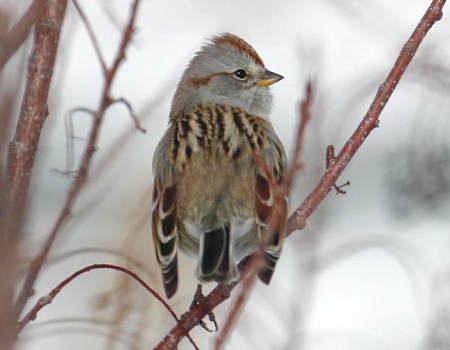 |
|
photo by Jack Binch |
American Tree Sparrow
by Tuula Rose
If you are a lister, there are a number of winter species that you would be looking for right now to get your numbers up where you want them by the end of the year. American tree sparrow is one of those migrants whose wintering grounds are the Southern Canadian Provinces and northern United States, pretty much from east to west, but more concentrated in the plains states according to Christmas Bird Count Statistics.
In Utah they are considered an uncommon winter visitor in their preferred habitat of fields, marshes and brushy edges of open spaces. In Utah County your best bet of finding one, or more likely a small flock of 3 or 4 is somewhere around Utah Lake, the Airport Dike, the Boat Harbor, maybe Powell Slough.
Seems that I always need to brush up on the field marks of migrants not to confuse them with similar species. Here are some comparisons with other sparrows that have a rusty cap. (By the way, the good old Peterson Field Guide shows the rusty-capped sparrows on the same page for good comparison.)
- The chipping sparrow at first glance is a look-a-like, except the line through the eye and behind the eye in ATS is rusty to match the cap color instead of black. And remember that chipping sparrows are not here in the winter!
- The swamp sparrow, rare here in the winter, has a rusty cap, but it has a dark-colored bill and no wing bars, when the ATS has a bi-colored bill with black upper and yellow lower mandible, and two white wing bars.
- The first year white-crowned sparrow, an abundant all-year resident in similar habitats, has rusty stripes on the crown and a clear breast, but is lacking the best identifying field mark of the ATS, the dark central spot on the clear breast.
Both sexes are alike and they are monogamous. Despite its name, it forages on the ground. It eats nearly 100% animal matter (insects and spiders) in the summer and turns to eating entirely seeds and other plant foods in the winter. It breeds in the arctic far north in Alaska and Canada, above the tree line and nests on the ground. It is abundant and widespread throughout its range.
American Tree Sparrow’s call is a musical “teedle-eet”. The song begins with several clear notes, followed by a variable and rapid warbler. Both sexes use calls, but male sings only one song. The flight call is a high and sharp “tsiiw”.
I found an interesting tidbit of information on this sparrow on the web (Cornell Lab):
“A study found that the American Tree Sparrow seems to
prefer to look for predators out of its left eye. This preference may be because
the right hemisphere of the brain is dominant for processing visual information.
Oddly, the Dark-eyed Juncos examined in the same study preferred to look out of
their right eyes.” - Who knew!
---------------------
[ The Bird of the Month is a new monthly column in our
newsletter. We will ask a club member (that’s you) to write about a bird each
month. Tuula Rose has agreed to coordinate the Bird of the Month column. If you
have a bird you want to write about let Tuula know before your bird is taken by
someone else. ]
Field Trip
Report
Bald Eagle Day at Farmington Bay - 10 February 2007
by Eric Huish
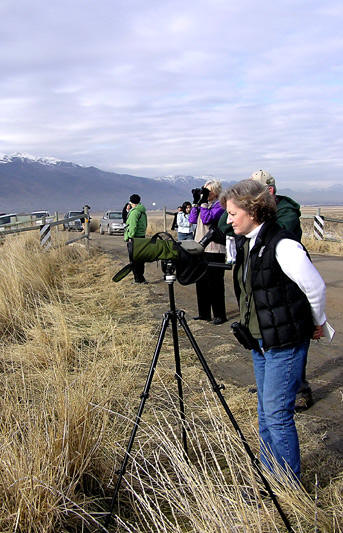 |
|
Yvonne and other UCB Participants
watching Eagles at Farmington Bay - 10 February 2007 |
Seven Utah County Birders met at 8:00 a.m. at the East Bay Sam’s Club Parking
lot where we were told our leader was ill and couldn’t make it. We appointed Ned
Bixler our leader and headed North. We met two more Utah County Birders at
Farmington Bay.
We had heard that there weren’t good numbers of eagles at Farmington Bay this
year but when we got there we were pleased to see MANY Bald Eagles. I counted 70
Eagles from one spot and we saw at least 100 Eagles in and around Farmington
Bay.
There were also lots and lots of people out for the Official Bald Eagle Day. It
was good to see so many people out enjoying birds.
Besides all the eagles we also saw hundreds and hundreds each of Tundra Swans,
Canada Geese, Northern Pintail, Northern Shoveler, Green-winged Teal and
Ring-billed Gulls at Farmington Bay.
In smaller numbers we saw Gadwall (quite a few), Mallard (lots), Cinnamon Teal
(6), Canvasback (1), Redhead (a few), Lesser Scaup (2), Bufflehead (2), Common
Merganser (lots and lots), Ruddy Duck (2), Pied-billed Grebe (2), Great Blue
Heron (2), Northern Harrier (about 6 or 7), Red-tailed Hawk (1), Rough-legged
Hawk (1), American Kestrel (4), American Coot (2or 3), Killdeer (1), California
Gull (lots), Herring Gull (lots), Common Raven (a few), European Starling (I
only noticed one in Farmington Bay), Song Sparrow (heard only) and Red-winged
Blackbird (heard only).
It turned out to be a beautiful sunny day. After the weeks of below freezing
temperature it felt nice to spend some time outside in 50 + degrees.
-----------------------------------------
Field Trip
Report
Delta, Snow Geese - 3 March 2007
by Merrill Webb
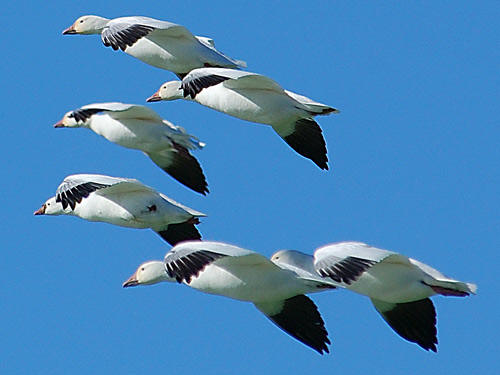 |
|
|
We got great views of Snow Geese
Flying in right near us - 3 March 2007 |
|
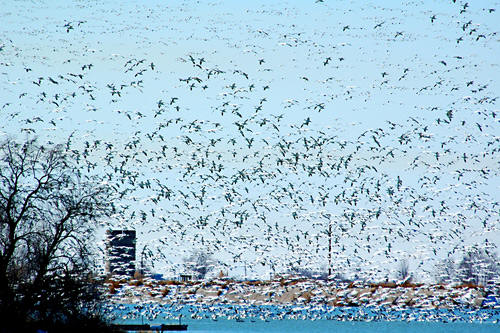 |
|
|
Geese filled the sky in Delta - 3
March 2007 |
|
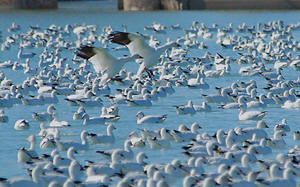 |
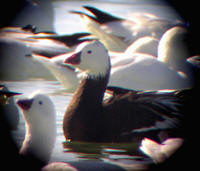 |
|
Snow Geese on Gunnison Bend Res. - 3
March 2007 |
Uncommon dark phase Ross's Goose - 3
March 2007 |
For those returning from the 250 mile roundtrip to Millard County on
Saturday, March 3, there were smiles all around. And why not? Mother Nature had
served up a smorgasbord of at least 50 different birds including 18 species of
migrating waterfowl.
So," you say, "I've seen Snow Geese before. Got my Snow Goose for the year at
Utah Lake State Park in January."
Too bad. You haven't seen them like we saw them at Gunnison Bend Reservoir near
Delta. Not like this time, you haven't. "Ross's Goose? No big deal--seen it
before, too." Uh huh.
I would bet it's been a long time since you saw close to 1,000 Snow Geese
sitting on ice, accompanied by 13 early migrating Avocets. Or watched wave after
wave after wave of beautiful white geese homing in on the little bit of open
water on the reservoir and then covering it to the extent that any open water
was difficult to see. And then, sorting through all the Snow Geese to find at
least 2-300 Ross's Geese, including a rare blue phase one, among the more than
12,000-15,000 Snow Geese. It was just spectacular, and hard to describe to
someone who wasn't there. all of this in spite of the bone-chilling,
finger-numbing cold. and to top it off there were all kinds of ducks in their
splendid nuptial plumage: Mallards, Canvasbacks, Redheads, Common Mergansers,
Green-winged Teal--all provided excellent looks. Even a lone Clark's Grebe
mingled in among the ducks. There were also California and Ring-billed Gulls on
the ice, a Mountain Chickadee in the brush below the dam, and a Great-tailed
Grackle in the residential area by the reservoir. As good as all this was, these
birds were just the appetizer.
On the way to Clear Lake Waterfowl Management Area, about 20 miles south of
Delta, we spotted a pair of Prairie Falcons.
Upon arriving at the management area we were greeted to ponds totally frozen
over with ice (didn't look very productive, at first sight). However, there was
one isolated area that was ice free which begged investigation. With eight
observers sharing four different spotting scopes and some standing in the back
of pick-ups to facilitate better viewing of the ducks, one would expect that
nothing could escape detection. And nothing did. Waterfowl were concentrated in
this small patch of open water by the hundreds. There were fourteen different
species represented: a single male Bufflehead, a pair of Common Goldeneyes, a
pair of Lesser Scaup, 20-30 Cinnamon Teal, a few Gadwall, and lots of Redheads,
American Wigeon, and Northern Pintail. As Eric was scanning the mixed flock of
ducks with his scope I heard him gasp, in fact it was more of an expulsion of
air. "A Eurasian Wigeon!" Sure enough a beautiful male wigeon, one considered by
the Utah records committee as an 'occasional transient', and without doubt the
best bird of the trip--the dessert, if you will.
All of us had a chance to view the wigeon--and it wasn't easy while it
intermingled with all the other ducks, swimming in and out of view among the
Redheads and American Wigeon. While watching these ducks we were treated to the
courtship flight of a Northern Harrier as well as a flight of more than 120
White Pelicans gleaming white in the blue sky as they wheeled in gigantic
circles high above us.
Thanks to Lu Giddings, the trip leader. Other participants included Ned Bixler,
Yvonne Carter, Eric Huish, Junice Markham, LeIla Ogden, Bonnie Williams and
Merrill Webb. Also, Lynn Garner and his wife met us at Clear Lake and then left
shortly before we found the wigeon.
Backyard Bird of the
Month
February 2007
Steve Carr - Holladay
Sharp-shinned Hawk - Three visits in one month.
Eric Huish - Pleasant Grove
Red-tailed Hawk - Flew over.
Milt Moody - Provo
Fox Sparrow still here -- going on 3 months.
Cheryl Peterson - Provo
An American Kestrel made three attempts to take House Finches off the
feeders.
Bruce Robinson - West Jordan
American Goldfinch - What's not to like about these little guys?
Tuula Rose - Provo
Mourning Dove, first of the year, scratching the snow under the feeders
for seeds.
Alton Thygerson - Provo
Northern Flickers - 2 at the same time.
Bonnie Williams - Mapleton
Downy Woodpecker - always fun to see.
We would like you to share your favorite backyard bird each
month. Please send your favorite bird at the end of the month to
newsletter@utahbirds.org or call 360-8777. If you would like a reminder at
the end of the month e-mail the above address.